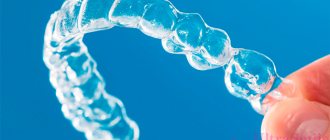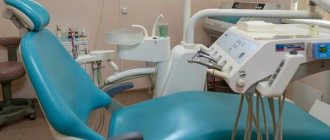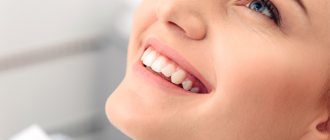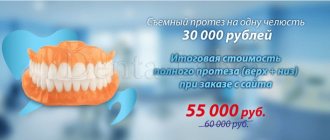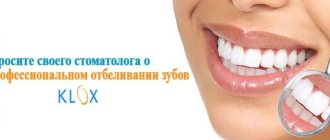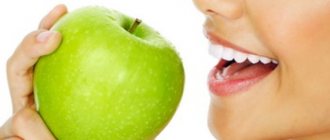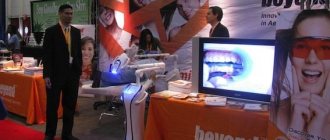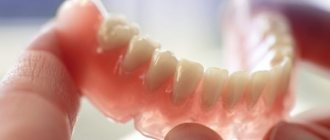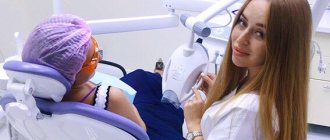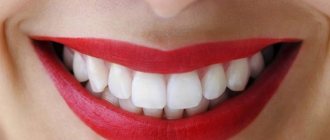Author of the article:
Soldatova Lyudmila Nikolaevna
Candidate of Medical Sciences, Professor of the Department of Clinical Dentistry of the St. Petersburg Medical and Social Institute, Chief Physician of the Alfa-Dent Dental Clinic, St. Petersburg
Cold lamp teeth whitening is one of the most modern ways to lighten enamel. The procedure is carried out using a special LED lamp with cold light.
This method is often confused with whitening with a conventional incandescent lamp, which heats the enamel, which is unsafe for the teeth, as it leads to their cracking, and also causes a lot of unpleasant sensations during the process itself. It is no wonder that patients are often distrustful of lamp bleaching.
The impact of an LED lamp is very different from a standard one; Let's figure out how effective and safe it is, and whether we should be guided by old stereotypes.
This is one of the photobleaching methods
Photo whitening allows you to radically transform your smile in just one visit to the dentist. The technology is also called “light”, since during its implementation the doctor acts on the tooth pigment through lamps emitting cold or hot light.
The principle of removing pigment from enamel is similar in all photobleaching methods. It is assumed that a gel with hydrogen peroxide or urea (reagent) and light (catalyst) will be used. Under the influence of a light lamp, the gel releases active oxygen, which penetrates deep into the tissue and removes pigment.
Doctor Zubastic recommends
By following simple rules, you can save the result for a long time:
- After the cold beam whitening procedure, you cannot lighten your teeth at home with hydrogen peroxide, salt, soda, or other folk remedies. This leads to damage to the enamel.
- If you cannot stop drinking coffee, red wine and foods containing dyes, brush your teeth after every meal. No opportunity? Use special mouth rinses, sprays, and irrigators. This will help prevent the formation of plaque and stone, which are precursors to darkening of the enamel. This also applies to those people who smoke. Under the influence of nicotine, even lightened enamel will turn yellow.
- Be sure to cleanse your mouth twice a day – morning and evening.
- Visit the dentist once every six months.
- Don't use toothpicks. An alternative to them is dental floss.
- Eat less foods containing sugar. They contribute to the proliferation of bacterial infections in the oral cavity.
- Include green apples and dairy products - cottage cheese, milk, cheese - in your diet. They are rich in calcium, which will help strengthen dental tissue.
Only careful oral care, diet and your efforts will help you maintain a Hollywood smile for a long time.
Tags: Amazing White, Beyond, LED lamp, Luma Cool, lamp whitening, whitening, photo whitening
About the author: Dr. Zubastik
Typically, a toothache begins to subside on the way to the clinic and finally goes away after 10 minutes of sitting in line to see the dentist.
- Related Posts
- A new word in dentistry: teeth whitening using the Magic White method
- How to choose an irrigator for braces?
- How do braces work?
« Previous entry
Carried out using halogen lamps
Cold teeth whitening involves the use of a gel activated by halogen lamps, the radiation of which is passed through special filters. As a result, the teeth are exposed to high-intensity, cool blue light.
Halogen lamps have the least negative effect on enamel
It is believed that halogen lamps have the least negative effect on the enamel and do not cause pain during and after the procedure. During operation, they do not heat tissues, as do ultraviolet and LED devices used, for example, for ZOOM technology, which also belongs to the category of photo-bleaching. However, the same “ZOOM” has its own advantages, because the developer has created a gel for these lamps, which contains components that strengthen and reduce the increased sensitivity of the enamel.
Cold light is light that does not have ultraviolet or infrared radiation; its temperature is approximately 37 ° C (almost the same as that of the human body). Due to this temperature regime, the procedure is as comfortable and painless as possible for the patient.
Cholisal gel is an effective dental preparation
The pharmaceutical market offers many compounds used in dentistry and other areas of medicine that have a complex effect. Cholisal gel is one of the most effective combination drugs that has:
- anti-inflammatory;
- antimicrobial;
- analgesic effect,
which makes it possible to effectively use it in treating the oral cavity and treating various ailments.
Properties and composition
Dental gel is a homogeneous transparent mass to which no dyes are added. The basis of the solution is oil produced from anise seeds, which gives the product a certain specific smell.
The composition includes several active components, namely:
- citalkonium chloride, which is an effective antiseptic substance that can have a detrimental effect not only on pathogenic bacteria and fungal microorganisms, but also on viruses;
- choline salicylate, capable of penetrating into tissues, providing not only an antipyretic, analgesic and anti-inflammatory effect, but destroying both fungal life forms and microbes, stopping the activity of microorganisms living in acidic and alkaline environments,
allowed pharmacists to create a drug that promotes the complex treatment of common dental diseases.
Cholisal: application and principle of action
The gel form used in the treatment of dental diseases allows for complex treatment of the oral cavity, since the active substances of the drug are capable of:
- block inflammatory mediators in soft tissues;
- effectively suppress the activity of pathogenic microflora;
- anesthetize affected tissue areas.
Therefore, experts recommend Cholisal as one of the most effective means to eliminate several consequences of diseases.
In addition, the effectiveness of the composition can be enhanced by prescribing the use of the drug in conjunction with prescribed rinsing procedures with active antiseptics, for example, chlorhexidine.
In addition to its excellent healing properties, the use of the gel helps to provide:
- prolonged effect of the drug on the mucous membranes;
- high efficiency in eliminating inflammatory phenomena;
- relief of painful sensations, which is facilitated by the rather viscous consistency of the composition, which helps the active substances to be quickly absorbed into the affected tissues, fighting foci of inflammation.
However, Cholisal, the price of which is quite high, cannot be used without appropriate doctor’s recommendations.
Cholisal gel, the instructions for use of which include purchasing the medicine without a prescription, can be successfully used to treat diseases in people of any age, but the smell and taste of anise oil can cause excessive salivation, therefore Cholisal is not recommended for use in infants.
Cholisal gel: instructions for use and indications for use
The antimicrobial, anti-inflammatory and analgesic effectiveness of the drug allows specialists to successfully use the drug in the treatment of such oral diseases as:
- gingivitis;
- periodontitis;
- inflammation during the eruption of wisdom teeth;
- inflammation of the mucous membranes as a result of wearing dentures;
- traumatic injuries to the oral mucosa;
- stomatitis,
It also helps reduce pain when molars appear in children.
For gingivitis and periodontitis
Based on the instructions for use of the drug, experts recommend using the gel in combination with other medicinal formulations and therapeutic measures.
So, when gingivitis or periodontitis is detected, in addition to cholisal, the following is usually prescribed:
- removal of deposits;
- antiseptic rinsing procedures;
- using special cleaning pastes to reduce inflammation;
and in severe cases of the disease - antibacterial therapy.
Self-medication, which involves using only a gel composition, will not help complete recovery from the disease, but the disease can take a chronic form, which can cause tooth loss.
The course of treatment with Cholisal gel prescribed by the dentist is carried out for ten days. Applications are carried out twice a day, usually in the morning and evening hours, after eating, since the procedure requires:
- thorough brushing of teeth;
- mouth rinses with antiseptic agents;
- drying the mucous surfaces of the gums
and only after this, apply the gel to the areas of inflammation.
The composition is applied both to the front and back walls of the gums, located on the side of the tongue, and such treatment requires avoiding the use of liquid for half an hour after the end of the procedure.
Some ingredients of the gel help increase salivation, so saliva should be swallowed without much fear, since the drug causes virtually no side effects.
For stomatitis
In the treatment of stomatitis, Cholisal gel is usually prescribed to reduce the pain of ulcers accompanying the course of the disease, however, the use of this remedy alone does not cure the disease, since the active substances of the drug are not able to fight herpes viruses, which are mainly the causative agents of this disease .
The allergic form of stomatitis must be treated by other means, therefore, for such diagnoses, these compounds are used only for symptomatic therapy.
Cholisal gel for teething
Using the drug when the first baby teeth appear in babies is quite dangerous, since the active work of the salivary glands will cause saliva flowing from the child’s mouth to irritate the delicate skin. In addition, excess saliva can lead to more tragic consequences, as the baby may choke.
However, at an older age, the use of a gel to anesthetize the process and relieve inflammation is quite justified.
Before applying the drug, it is recommended to dry the gum area with a swab and lightly apply the product. Usually, the procedure is repeated 3-4 times a day, but for children of the younger age group, experts advise using special products that are produced in the form of:
- candles;
- syrups;
- tablets.
The appearance of wisdom teeth is also a rather painful process, however, the use of Cholisal gel in these cases is recommended if the following is not observed:
- discharge of purulent masses;
- swelling of the cheeks or gums;
- pain when swallowing;
- difficulty opening and closing the mouth;
- temperature rise;
- unpleasant smell
since, if such symptoms appear, you should immediately contact your dentist.
Possible unwanted effects
The instructions prescribe using the drug with caution during pregnancy and breastfeeding, that is, the product must be recommended by a specialist, which involves monitoring its use and abandoning the gel, if necessary.
Thus, domestic medicine does not prescribe treatment with Cholisal gel during the first trimester of pregnancy.
Complications and negative consequences when using Cholisal gel were observed by practicing doctors extremely rarely. However, increased individual sensitivity to the ingredients of the drug can manifest itself as:
not a strong burning sensation in the areas where the product was applied;
These side effects most often disappear within a few minutes.
However, when the first unwanted symptoms appear, experts recommend stopping using the gel, since the cause of an allergic reaction may be:
- salicylates;
- anise oil,
as well as other ingredients included in the product.
In addition, dentists advise using the optimal amount of the drug during procedures, avoiding overdose.
In addition, it should be taken into account that the use of cholisal with other analgesics, anti-inflammatory drugs, antipyretic syrups can increase the concentration of active substances in the body, and an excess of antibiotics and antiseptics can also cause an allergic reaction.
Considering the free sale of Cholisal gel in pharmacies, before purchasing and using the drug, you should consult with a specialist, which will allow you to use the modern combined action product most effectively.
Rare analogues
Despite the development of the pharmaceutical industry, the domestic market is not happy with effective drugs with combined effects that can help in the treatment of dental diseases.
Quite often, doctors use Munzidal gel, which is considered an analogue of Cholisal, however, this drug is quite expensive, with a smaller packaging volume and quite comparable effectiveness.
Gentle on enamel and gums, does not cause pain
Experts say that teeth whitening with cold light eliminates the possibility of injury, overheating and overdrying of hard tissues, as well as increased enamel sensitivity after the procedure. When carrying out manipulations there is no risk of burns or irritation of the mucous membrane.
Cold whitening is a gentle method
“I’ve been wanting to try cold whitening for a long time. True, because of the name, I was afraid that the cold would set my teeth in the process, but it turned out that this was not the case at all. During the procedure, I very carefully monitored the sensations that arose: when the gel was applied, I felt a slight tingling sensation, but I did not have any direct pain or cramps. Everything is tolerant and acceptable! On the first day, of course, my teeth ached, there’s no way around it, but less than with chemical whitening, which I did before. By the second day I already felt completely fine.”
Viki_Niki, review from otzovik.com
Will not cope with hypoplasia and fluorosis
The technology will not be effective against non-carious lesions and stains that affect the aesthetics of the smile: hypoplasia, fluorosis, wedge-shaped defect. Especially if the pathologies are severe.
Are any of the professional whitening methods effective for the listed defects? Researchers claim that some types of hypoplasia, mild fluorosis and even tetracycline teeth are best treated with ZOOM technology. But most often, such patients are still offered to install veneers, lumineers and crowns (if the teeth are severely damaged), which, in addition to adding aesthetics to the smile, help protect the enamel from external influences, destruction and caries.
The technology will not be effective against fluorosis
Allows you to lighten teeth by 6–10 shades
Teeth whitening without heat or laser is safer than with it. However, the effect of using this technology will not be so impressive: not 8–12, but 6–10 tones. The maximum positive result can be achieved if darkening or yellowing of the enamel was caused by smoking, consumption of food and drinks with dyes, or age-related changes.
Some doctors do not advise teeth whitening with cold light if the enamel has a natural gray tint, because then the maximum that can be achieved will be only 2-3 tones.
A smile can be lightened by 6–10 tones
Preparation for the procedure
Whitening with gel and LED lamp is carried out only in dental clinics. Portable compact devices for home use have not yet been created.
Important! A week before lamp bleaching, it is not recommended to consume foods and drinks that contain natural dyes - coffee, wine, sweet soda, berries, sauces, seasonings, beets, carrots.
Stages:
- The first step is thorough cleaning of the oral cavity: existing plaque is removed from the teeth. Otherwise, whitening will occur not of the teeth, but of the plaque. At this stage, doctors perform fluoridation using special preparations that create a protective film on the tooth and strengthen the enamel. One of the most common methods of removing plaque is the Air-Flow sandblasting technique.
- Then the dentist will select the shade of enamel according to the Vita scale, depending on your wishes.
- The next stage is to isolate the lips and cheeks from the teeth using special wipes and cream.
- To protect the gums from the effects of the chemically active gel, a liquid cream is used, which hardens after application and forms a protective barrier.
Brush your teeth with fluoride toothpaste once a day, as high fluoride content can lead to fluorosis. That is, for example, at night you should brush your teeth with a fluoride-containing paste, and in the morning with a paste containing extracts of medicinal herbs.
Cold teeth whitening techniques
Amazing White: this is one of the most popular and safest methods today, allowing you to lighten the enamel by 6-10 tones. At the same time, dentists who use the technique in their practice assure that you will get a natural color, and there is no risk of unnatural whiteness.
Amazing White is one of the most popular whitening methods
Beyond Polus: allows you to whiten teeth in different clinical cases, since the device designed for the procedure has several operating modes (soft, normal and intensive). According to a number of studies2, Beyond lamps emit minimal heat compared to similar devices from other manufacturers. Beyond International also offers patients the opportunity to purchase a halogen lamp for home use, but more details about this and much more can be found in the feature article on the website.
Beyond lamps produce minimal heat
Luma-Arch (“Luma Arch”): using this method you can lighten the enamel by 6-8 tones. To do this, you will only need to make 1 visit to the dentist and spend about 30 minutes (the teeth are lightened in three approaches of 8 minutes each). The method is not as popular in Russia as the others that were listed earlier.
Notice
: Undefined variable: post_id in
/home/c/ch75405/public_html/wp-content/themes/UltraSmile/single-item.php
on line
45 Notice
: Undefined variable: full in
/home/c/ch75405/public_html/wp-content /themes/UltraSmile/single-item.php
on line
46
Rate this article:
( 1 ratings, average: 5.00 out of 5)
whitening
- Androsenko N.I. Comparative characteristics of teeth whitening methods in therapeutic dentistry // Bulletin of medical Internet conferences. – 2022.
- Lutskaya I.K. Current state of the problem of teeth whitening // International reviews: clinical practice and health. – 2022.
Expert “Teeth whitening with cold light is one of the safest technologies. But this does not negate careful preparation for the procedure, including professional oral hygiene, strengthening the enamel through fluoridation and remineralization, and the use of special pastes that reduce the sensitivity of hard tissues. It is also necessary to exclude contraindications: age under 18 years, multiple caries, acute inflammation of the gums, oncology, a large number of fillings or the presence of artificial crowns in the smile area.” Dental hygienist Victoria Nikolaevna Kashaeva
Consulting specialist
Kashaeva Victoria Nikolaevna
Specialization: Dental hygienist Experience: 8 years
Techniques
All technologies used in domestic clinics are foreign developments and equipment.
Unfortunately, we don’t yet have our own analog systems—hence the high cost of the service. Let's consider the most popular systems:
- Beyond Polus – created using unique Light Bridge technology.
It is based on the use of halogen lamps. This eliminates the negative impact on the patient’s body of ultraviolet radiation used during standard enamel lightening. Moreover, it does not heat the surface and ensures the most uniform distribution of the composition; - Luma Cool is the most famous and popular system in Europe, but extremely limited here. It is the only patented technology in the world that allows you to use diode lamps rather than halogen lamps during a session.
- Amazing White – a novelty in the world of dentistry. Activates chemical processes thanks to the LED lamp.
The assortment line of this product is so diverse that it offers the consumer mini-kits for home use.Undoubtedly, their effectiveness will be an order of magnitude lower than salon whitening, but they are quite suitable as intermediate procedures. Representatives of this brand are systems with violet, red and blue light fluxes.
The purpose of determining the oral hygiene index and the methods used.
In this publication, read about the method of intra-canal teeth whitening.
Here https://www.vash-dentist.ru/krasota-i-uxod/otbelivanie/poloski/yotuel-razrabotka-po-evropeyskim-standartam.html all the most important things about Yotuel whitening.
Comments
There is a filling on the front tooth, will it be whitened using the methods you listed?
Valya (06/08/2020 at 01:15) Reply to comment
- Dear Valya, fillings and artificial crowns cannot be whitened by any of the methods existing today. If you want to whiten the enamel, then the filling will need to be changed so that it matches the color of the new shade of the teeth.
Editorial staff of the portal UltraSmile.ru (06/13/2020 at 09:15) Reply to comment
Is it possible to do cold bleaching immediately after air flow?
Laura (06/27/2020 at 01:24 pm) Reply to comment
- No, you need to wait at least 7–10 days: during this period you need to use special pastes and remineralizing compounds.
Editorial staff of the portal UltraSmile.ru (07/03/2020 at 09:47) Reply to comment
Will they give me an anesthetic injection before bleaching, otherwise I’m afraid...
Zverev S. (07/13/2020 at 15:47) Reply to comment
- Injection anesthesia is not used for such a procedure, but the gums and soft tissues will be treated with a special protective gel that reduces sensitivity and the likelihood of irritation of the mucous membrane.
Editorial staff of the portal UltraSmile.ru (07/17/2020 at 09:08) Reply to comment
